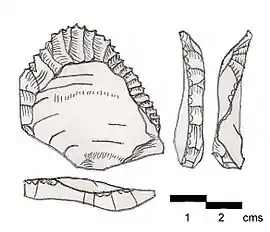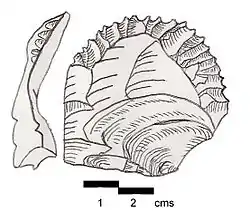

Ksar Akil Flake is an oval type of Lithic flake with fine, regular teeth at frequent intervals. The flint tool is named after the archaeological site of Ksar Akil in Lebanon, where several examples were found and suggested to date to the late Upper Paleolithic.[1]
Two Ksar Akil Flakes are held by the National Museum of Beirut, marked as "level V", which had a base point at around 3 metres (9.8 ft) below datum.[2] Other examples are held by the Archaeological Museum of the American University of Beirut, Lorraine Copeland and some are also likely to be among the Ksar Akil material held in London. Five other examples are held in the Museum of Lebanese Prehistory found at Borj Barajne in the Sands of Beirut along with two worn examples discovered at Antelias cave. Another Ksar Akil flake was found at El-Emireh.[1][3]
References
- 1 2 Lorraine Copeland; P. Wescombe (1965). Inventory of Stone-Age sites in Lebanon, p. 49 & Figure X, 7, p. 156. Imprimerie Catholique. Retrieved 21 July 2011.
- ↑ Hooijer, D. A., The Fossil Vertebrates of Ksar Akil, a Paleolithic Rock-Shelter in the Lebanon, Zoloögische Verhandelgingen, 49, 1, 1961.
- ↑ Ewing, J., Preliminary Note on the Excavations at the Paleolithic Site of Ksar Akil, Republic of Lebanon, Antiquity, vol. 21, p. 186, 1947